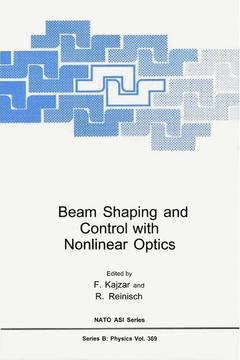Description
Beam Shaping and Control with Nonlinear Optics, Softcover reprint of the original 1st ed. 2002
NATO Science Series B: Series, Vol. 369
Coordinators: Kajzar F., Reinisch R.
Language: English
Subject for Beam Shaping and Control with Nonlinear Optics:
Keywords
Phase; communication; crystal; optics; polymer; polymers; telecommunications
Publication date: 03-2013
475 p. · 17.8x25.4 cm · Paperback
475 p. · 17.8x25.4 cm · Paperback
Description
/li>Contents
/li>
The field of nonlinear optics, which has undergone a very rapid development since the discovery of lasers in the early sixties, continues to be an active and rapidly developing - search area. The interest is mainly due to the potential applications of nonlinear optics: - rectly in telecommunications for high rate data transmission, image processing and recognition or indirectly from the possibility of obtaining large wavelength range tuneable lasers for applications in industry, medicine, biology, data storage and retrieval, etc. New phenomena and materials continue to appear regularly, renewing the field. This has proven to be especially true over the last five years. New materials such as organics have been developed with very large second- and third-order nonlinear optical responses. Imp- tant developments in the areas of photorefractivity, all optical phenomena, frequency conv- sion and electro-optics have been observed. In parallel, a number of new phenomena have been reported, some of them challenging the previously held concepts. For example, solitons based on second-order nonlinearities have been observed in photorefractive materials and frequency doubling crystals, destroying the perception that third order nonlinearities are - quired for their generation and propagation. New ways of creating and manipulating nonl- ear optical materials have been developed. An example is the creation of highly nonlinear (second-order active) polymers by static electric field, photo-assisted or all-optical poling. Nonlinear optics involves, by definition, the product of electromagnetic fields. As a con- quence, it leads to the beam control.
Introduction to Nonlinear Optics: A Selected Overview; G.I. Stegeman. Introduction to Ultrafast and Cumulative Nonlinear Absorption and Nonlinear Refraction; E.W. Van Stryland. From Dipolar Molecular Engineering to Multipolar Photonic Engineering in Nonlinear Optics; J. Zyss, S. Brasselet. Molecule Orientation Techniques; F. Kajzar, J.-M. Nunzi. Nonlinear Pulse Propagation Along Quantum Well in a Semiconductor Microcavity; V.M. Agranovich, et al. Some Aspects of the Theory of Light Induced Kinetic Effects in Gases; S. Kryszewski. Temporal and Spatial Solitons: An Overview; A. Boardman, et al. Spatial Solitons in Quadratic Nonlinear Media; L. Torner. Photorefractive Spatial Solitons; M. Segev, et al. Sub-Cycle Pulses and Field Solitons: Near- and Sub-Femtosecond EM-Bubbles; A. Kaplan, et al. Nonlinear Waveguiding Optics; R. Reinisch. Quadratic Cascading: Effects and Applications; G. Assanto. Nonlinear Optical Frequency Conversion: Material Requirements, Engineered Materials, and Quasi-Phasematching; M. Fejer. Low-Power Short Wavelength Coherent Sources: Technologies and Applications; D. Ostrowsky. Artificial Mesoscopic Materials for Nonlinear Optics; C. Flytzanis. Index.
© 2024 LAVOISIER S.A.S.




